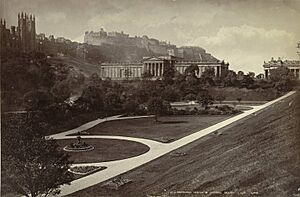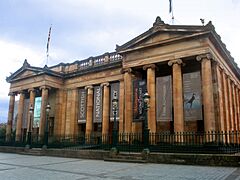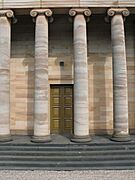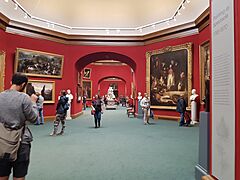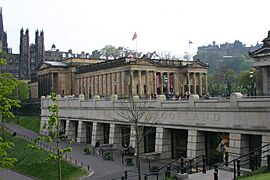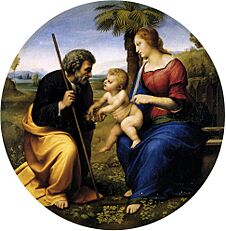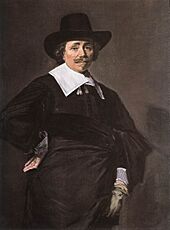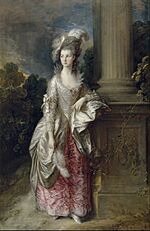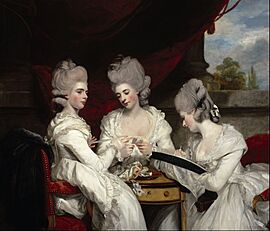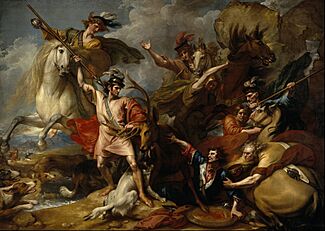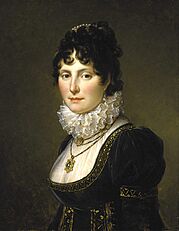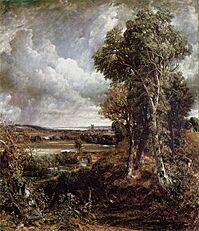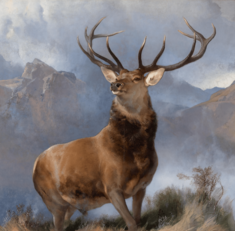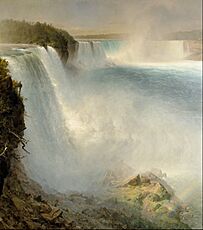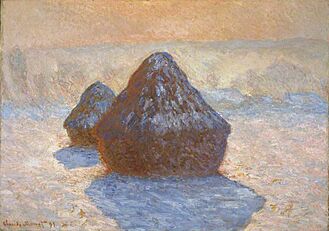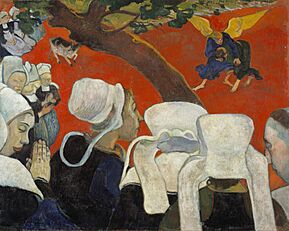Scottish National Gallery facts for kids
 |
|
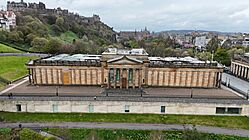
Scottish National Gallery (2025)
|
|
| Lua error in Module:Location_map at line 420: attempt to index field 'wikibase' (a nil value). | |
| Established | 1859 |
|---|---|
| Location | The Mound, Edinburgh |
| Visitors | 1,583,231 (2019) |
| Public transit access |
|
The National (also known as the Scottish National Gallery) is Scotland's main art museum. It is located in the heart of Edinburgh, on a place called The Mound, very close to Princes Street. The building was designed in a special style called neoclassical by an architect named William Henry Playfair. It first opened its doors to visitors in 1859.
This gallery is home to Scotland's amazing collection of fine art. You can see art from Scotland and from all over the world. The artworks range from the early days of the Renaissance (a time of great art and learning) up to the beginning of the 20th century.
The National gallery is managed by National Galleries Scotland. This is a public group that also looks after two other important art places: the Scottish National Gallery of Modern Art and the Scottish National Portrait Gallery. Because it looks a lot like the building next door, the Royal Scottish Academy Building (RSA), visitors sometimes get them mixed up! But they are separate places that work closely together.
Contents
A Look Back: The Gallery's History
The idea for Scotland's national art collection began in 1819. A group called the Royal Institution for the Encouragement of the Fine Arts in Scotland started collecting paintings. In 1828, their building opened on The Mound.
Later, in 1826, some artists who disagreed with the Royal Institution formed their own group, the Scottish Academy. This group became the Royal Scottish Academy (RSA) in 1838. A big goal for the RSA was to create a national art collection. They started their own collection and rented space in the Royal Institution building from 1835.
Building a New Home for Art
In the 1840s, plans were made for a brand new building to house the RSA. William Henry Playfair, a famous Scottish architect, was chosen to design it. On August 30, 1850, Prince Albert laid the first stone for the building.
The building was originally split into two halves. The eastern side held the exhibition galleries for the RSA. The western side became the new National Gallery of Scotland, showing art from the Royal Institution's collection. In 1912, the RSA moved into the old Royal Institution building. This building is still known as the Royal Scottish Academy Building. After this move, the National Gallery focused on building its own permanent collection of Scottish and European art for the whole country.
Modern Updates and Name Changes
In the early 2000s, the National Galleries started a project called the Playfair Project. This project created a new entrance for the National Gallery in Princes Street Gardens. It also added an underground area called the Weston Link, which connects the gallery to the renovated Royal Scottish Academy building. This new underground space opened in 2004.
In 2012, the group that runs the galleries, National Galleries of Scotland, changed its name. The National Gallery of Scotland was then called the Scottish National Gallery. In 2023, the organization changed its name again to the shorter National Galleries Scotland. Now, the Scottish National Gallery is known as National Galleries Scotland: National.
The Gallery Building: An Ancient Greek Style
William Playfair designed the gallery building to look like an ancient Greek temple. Its neighbor, the Royal Scottish Academy, also has this style. Playfair used different types of Greek columns for each building. The RSA has Doric order columns, while the National Gallery uses the more decorative Ionic order.
The building has grand entrances on its east and west sides. These feature columns and a central block. The design shows how the building was originally split. The RSA exhibitions were on one side, and the National Gallery was on the other.
Playfair had a smaller budget for the National Gallery than for the RSA. This is why its style is a bit simpler. He might have been inspired by other designs from the time. The gallery was built in a cross shape. Playfair originally planned towers at the corners, but these were not built. When the RSA moved out in 1912, the inside of the National Gallery was changed to hold only its own art collection.
Expanding the Space
In the 1970s, the gallery added more space inside. An upper floor was added at the south end in 1972, creating five new small galleries. In 1978, a new gallery opened in the basement to show the Scottish Collection.
The new entrance from Princes Street Gardens and the underground area opened in 2004. This project took five years to build and cost £32 million. This area includes a lecture theater, an education space, a shop, a restaurant, and an interactive gallery. It also has the link to the RSA building.
In January 2019, another big project began to update the lower levels and create even more exhibition space. The Princes Street Gardens entrance became the main entrance for the gallery. To make it easier to reach, East Princes Street Gardens was redesigned with sloping paths. Some trees were removed and replaced with new ones. This project faced delays until late 2022 due to the discovery of asbestos and challenges from the COVID-19 pandemic. The improved gallery spaces and main entrance officially reopened in July 2023.
- Architectural features
Learning and Research
The National Gallery offers great resources for learning and research. It has a Prints and Drawings Collection with over 30,000 works on paper. These range from the early Renaissance to the late 19th century.
There is also a Research Library. This library has about 50,000 books, journals, and other materials. It covers art from 1300 to 1900. It also holds some old documents about the gallery's collections and history. You can visit the Print Room or Research Library by making an appointment.
The Art Collection
The heart of the National Gallery's collection comes from paintings transferred from the Royal Scottish Academy. This includes amazing works by artists like Jacopo Bassano, Van Dyck, and Giambattista Tiepolo. The gallery didn't get its own money to buy art until 1903.
Famous Artworks to See
In the main rooms on the ground floor, you can see several very large paintings. These include Benjamin West's Alexander III of Scotland Rescued from the Fury of a Stag (1786). There's also Rubens's The Feast of Herod (1633 or c.1637-38). You can also find two paintings by Titian, Diana and Actaeon and Diana and Callisto. The gallery also shares ownership of one of Canova's sculptures, The Three Graces, with the Victoria and Albert Museum.
The Scottish National Gallery has a wonderful collection of art by Scottish artists. You can see landscapes by Alexander Nasmyth. There are also several works by Sir Henry Raeburn, including his famous portraits of Alexander Ranaldson Macdonell and Sir Walter Scott. His well-known painting, The Skating Minister, is also here. You'll also find art by artists from the Glasgow School, like James Guthrie.
The gallery also has works by English painters. These include Constable's The Vale of Dedham. There's also a large collection of watercolors by Turner, which are usually shown in January. The Monarch of the Glen, a painting that shows the beauty of Scottish wildlife and scenery, is also in the gallery. It was painted by the English artist Sir Edwin Landseer.
Key Works of Art Displayed
Here are some of the most important artworks you can see at the National Gallery:
- Gian Lorenzo Bernini, Carlo Antonio dal Pozzo and Design for a Papal Monument
- Sandro Botticelli, Virgin Adoring the Sleeping Christ Child
- Frans Hals, Portrait of Pieter Verdonck
- Antonio Canova, The Three Graces (displayed on rotation with the Victoria and Albert Museum in London)
- Paul Cézanne, The Big Trees and Montagne Sainte-Victoire
- Jean Siméon Chardin, Vase of Flowers
- John Constable, The Vale of Dedham SNG
- Gerard David, Three Legends of St Nicholas
- Edgar Degas, Portrait of Diego Martelli
- James Drummond, The Porteous Mob and A Lady Descending from a Sedan Chair. Study for the Painting The Porteous Mob
- Anthony van Dyck, The Lomellini Family
- Thomas Gainsborough, Portrait of Mrs Mary Graham
- Paul Gauguin, Vision after the Sermon
- Hugo van der Goes, The Trinity Altarpiece (on loan from the Royal Collection)
- Vincent van Gogh, Olive Trees
- Francisco de Goya, El Medico
- El Greco, Saint Jerome in Penitence, Fábula and Christ Blessing (The Saviour of the World)
- Gavin Hamilton, Dawkins and Wood Discovering the Ruins of Palmyra
- Jean-Auguste-Dominique Ingres, Mlle Albertine Hayard
- Edwin Landseer, The Monarch of the Glen
- Lorenzo Lotto, Madonna and Child with Saints
- Claude Monet, Haystacks
- Joseph Noel Paton, The Quarrel of Oberon and Titania
- Giambattista Pittoni, St Jerome and Peter of Alcantara
- Nicolas Poussin, The Seven Sacraments
- Sir Henry Raeburn, The Reverend Robert Walker Skating on Duddingston Loch
- Allan Ramsay, Margaret Lindsay
- Raphael, The Bridgewater Madonna
- Rembrandt van Rijn, A Woman in Bed and Self-Portrait
- Sir Joshua Reynolds, The Ladies Waldegrave
- Pieter Jansz Saenredam, Grote Kerk, Haarlem
- Georges Seurat, La Luzerne, St-Denis
- John Singer Sargent, Lady Agnew of Lochnaw
- Titian, Venus Anadyomene, Diana and Callisto, Diana and Actaeon, The Virgin and Child with St John the Baptist and an Unidentified Saint, and The Three Ages of Man
- Joseph Mallord William Turner, Somer Hill and the Vaughan Bequest of 38 works
- Diego Velázquez, Old Woman Frying Eggs
- Johannes Vermeer, Christ in the House of Martha and Mary
- Antoine Watteau, Fêtes Vénitiennes
- Notable artworks in the Scottish National Gallery collection
-
Portrait of François Wouters
(Frans Hals, about 1644) -
Portrait of Mrs Mary Graham
(Thomas Gainsborough, 1775) -
The Ladies Waldegrave
(Joshua Reynolds, 1780) -
Alexander III of Scotland Rescued from the Fury of a Stag
(Benjamin West, 1786) -
Portrait of Mary Nisbet
(François Gérard, 1803) -
The Vale of Dedham
(John Constable, 1828) -
The Monarch of the Glen
(Edwin Landseer, 1851) -
Niagara Falls, from the American Side
(Frederic Edwin Church, 1867) -
Haystacks
(Claude Monet, 1891) -
Vision après le Sermon
(Paul Gauguin, 1888)
Other Artists You Might See
Many other talented artists have their works displayed here, including:
- David Allan
- Francis Bacon
- Federico Barocci
- William Blake
- Eugène Boudin
- David Young Cameron
- Gustave Courbet
- Aelbert Cuyp
- Eugène Delacroix
- Domenichino
- Albrecht Dürer
- William Dyce
- Adam Elsheimer
- John Emms
- Andrew Geddes
- Guercino
- James Guthrie
- Frans Hals
- Meindert Hobbema
- Hans Holbein the Younger
- Edward Atkinson Hornel
- Robert Scott Lauder
- Horatio McCulloch
- William York Macgregor
- William MacTaggart
- Lorenzo Monaco
- Berthe Morisot
- John Phillip
- Giovanni Battista Piranesi
- Camille Pissarro
- Robert Priseman
- David Roberts
- Peter Paul Rubens
- George Sanders
- William Strang
- Tintoretto
- Leonardo da Vinci
- Sir David Wilkie
- Francisco de Zurbarán
See also
- National Galleries of Scotland
- List of national galleries


